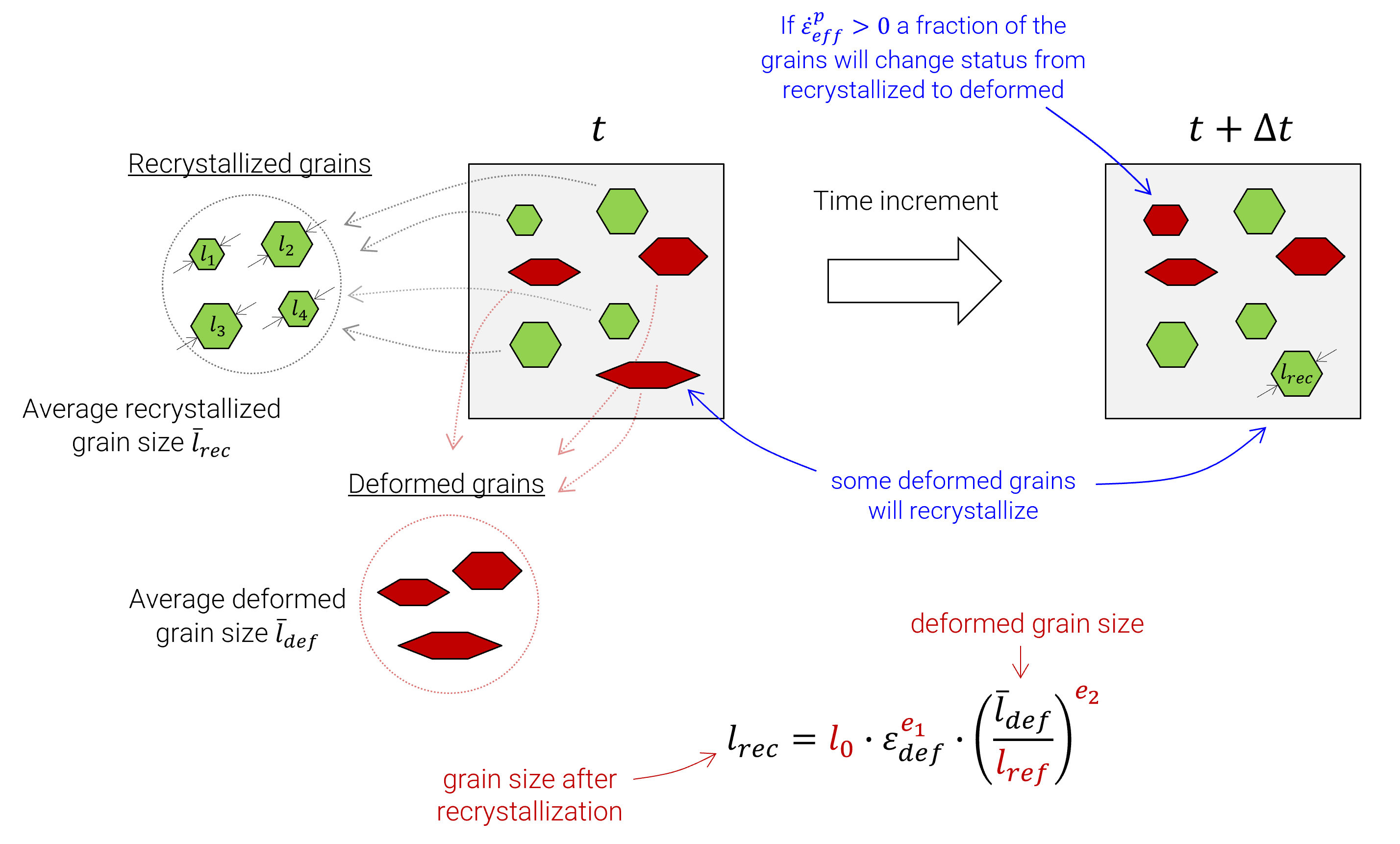MAT_HOT_FORMING
FE
Material properties
Beta command
This command is in the beta stage and the format may change over time.
"Optional title"
mid, $\rho$, $E$, $\nu$, did, tid
$c_{01}$, $c_{02}$, $c_{s1}$, $c_{s2}$, $B$, $Q$, $\dot{\varepsilon}_{off}$
$d_1$, $d_2$, $d_3$, $d_4$, $d_5$, $Q_{rex}$
$M$, $\alpha$, $U_0$, $V_0$, $v_D$
$e_1$, $e_2$, $l_{ref}$, $l_0$, $l_{cap}$, $l_{ini}$
$k_l$, $Q_l$, $n_l$
$\alpha_p$, $\beta_p$, $\gamma_p$, $f_p^{max}$, $f_p^0$, $Q_p$, $n_p$
Parameter definition
Description
This is a material model for hot forming operations. It accounts for a strain, strain rate and temperature dependent flow stress, recrystallization, precipitation hardening and recovery.
Flow stress
The flow stress is defined as:
$\displaystyle{ \sigma_y = \sqrt{ \sigma_s^2 + (\sigma_0 - \sigma_s)^2 \cdot \mathrm{exp}(-2B\bar{\varepsilon})} + \sigma_p}$
$\sigma_0$ is the yield stress, $\sigma_s$ is a saturation stress and $\sigma_p$ is a precipitate hardening stress.
$\displaystyle{\sigma_0 = c_{01} \cdot \mathrm{log} \left[ \left( \dot{\varepsilon}_{eff}^p + \dot\varepsilon_{off} \right) \cdot \mathrm{exp} \left( \frac{Q}{RT} \right) \right] - c_{02} }$
$\displaystyle{\sigma_s = c_{s1} \cdot \mathrm{log} \left[ \left( \dot{\varepsilon}_{eff}^p + \dot\varepsilon_{off} \right) \cdot \mathrm{exp} \left( \frac{Q}{RT} \right) \right] - c_{s2} }$
where $R$ is universal gas constant and $T$ is the temperature in Kelvin. $\bar{\varepsilon}$ is a measure of the average grain deformation (strain).
Grain deformation
The average grain deformation $\bar{\varepsilon}$ is defined as:
$\displaystyle{\bar{\varepsilon} = Y \cdot \varepsilon_{rec} + (1 - Y) \cdot \varepsilon_{def}}$
where $Y$ is the volume fraction of recrystallized grains, $\varepsilon_{rec}$ is the average deformation of the recrystallized grains and $\varepsilon_{def}$ is the average deformation of the grains that are not classified as recrystallized. The evolution of $\varepsilon_{rec}$ and $\varepsilon_{def}$ are:
$\displaystyle{\dot{\varepsilon}_{rec} = \dot{\varepsilon}_{eff}^p + \dot{\varepsilon}_{eff}^c - \frac{\dot{X}}{Y} \cdot \varepsilon_{rec}}$
$\displaystyle{\dot{\varepsilon}_{def} = \dot{\varepsilon}_{eff}^p + \dot{\varepsilon}_{eff}^c + \frac{\dot{X} - \dot{Y}}{1-Y} \cdot \left( \varepsilon_{rec} - \varepsilon_{def} \right) }$
$\dot{\varepsilon}_{eff}^p$ is the plastic strain rate, $\dot{\varepsilon}_{eff}^c$ is the recovery creep rate, $Y$ is the current volume fraction of recrystallized grains and $\dot{X}$ is the rate of recrystallization (volume fraction per unit time).
Note that $\varepsilon_{rec}$ decreases as deformed grains recrystallize $(\dot{X} \gt 0)$. Recrystallization means that completely undeformed grains are added to the group of (potentially) slighlty deformed recrystallized grains.
$\dot{Y}$ is the total growth rate of the recrystallized fraction. It is the difference between the recrystallization rate $\dot{X}$ and the rate at which recrystallized grains are reclassified as deformed grains.
Recrystallization
The recrystallization process is strongly temperature dependent and it is driven by both time (static recrystallization) and by plastic deformations (dynamic recrystallization). The rate of recrystallization $\dot X$ and the evoution of the fraction of recrystallized material $Y$ are defined as:
$\displaystyle{\dot X = \left( d_1 + d_2 \cdot \dot\varepsilon_{eff}^p \right) \cdot \varepsilon_{def}^{d_3} \cdot \left( \frac{\bar{l}_{def}}{l_{ref}} \right)^{d_4} \cdot \left( 1 - Y \right) \cdot \mathrm{exp} \left(-\frac{Q_{rex}}{RT} \right) \cdot \mathrm{exp} \left(-\gamma_p \langle f_p - f_p^0 \rangle \right) }$
$\displaystyle{\dot Y = \dot X - d_5 \cdot Y \cdot \dot{\varepsilon}_{eff}^p}$
$d_1, d_2, d_3, d_4, d_5, Q_{rex}, \gamma_p$ and $f_p^0$ are material constants. $d_1$ controls the static and $d_2$ the dynamic recrystallization process. $d_3$ defines the relationship between grain deformation and rate of recrystallization. $d_4$ is optional and specifies the grain size influence on the recrystallization process. The rate of recrystallization naturally drops as $Y$ grows (as there will be less and less material left to recrystallize). The final exponential scale factor is there to slow down the recrystallization process at particle fractions $f_p \gt f_p^0$ Hence, $f_p^0$ is a threshold value where precipitates begin to inhibit the recrystallization process.
Previously recrystallized grains can undergo new deformations. As they deform, they will gradually be declassified as "not recrystallized". The rate of this process is controlled with the parameter $d_5$.
Precipitation hardening
The precipitation hardening $\sigma_p$ is defined as:
$\displaystyle{\sigma_p = \alpha_p \cdot G(T) \cdot {f_p}^{n_p}}$
where $G(T)$ is the shear modulus and $f_p$ is the precipitate volume fraction. The evolution of $f_p$ depends on grain strain and on the temperature.
$\displaystyle{\dot f_p = \beta_p \cdot \bar\varepsilon \cdot \left( f_p^{max} - f_p \right) \cdot \mathrm{exp}\left( -\frac{Q_p}{RT} \right) }$
$\alpha_p, \beta_p, f_p^{max}, Q_p$ and $n_p$ are material parameters. The precipitation hardening contribution is often assumed to be proportional to the square root of the product between particle size and particle volume fraction. The particle size is not included in this model. It is compensated for by replacing the square root with a calibration exponent $n_p$.
The precipitation evolution law indicates a more rapid particle fraction growth at increased temperatures. However, high temperatures will also speed up the recrystallization process. Recrystallization reduces the average grain strain $\bar{\varepsilon}$ which, in turn, slows down the particle growth.
Recovery
Recovery is modelled as a redistribution of elastic to plastic strains (creep effect). The effective plastic recovery rate is defined as:
$\displaystyle{ \dot\varepsilon_{eff}^c = \frac{64 \left( \sigma_{eff} - \sigma_r \right)^2}{27M^3\alpha^2 G(T) E(T)} \cdot v_d \cdot \mathrm{exp} \left( - \frac{U_0}{RT} \right) \cdot \mathrm{sinh} \left( \frac{\left(\sigma_{eff} - \sigma_r \right) V_0}{RT} \right) }$
$G(T)$ and $E(T)$ are the shear and Young's moduli, respectively. $\sigma_r$ is a lower stress limit for recovery.
$\displaystyle{\sigma_r = c_{r1} \cdot \frac{Q}{RT} - c_{r2} }$
Grain size evolution
The grain size is assumed to grow with time and temperature and to change at recrystallization. The size of a recrystallized grain is:
$\displaystyle{ l_{rec} = l_0 \cdot \varepsilon_{def}^{e_1} \cdot \left( \frac{\bar{l}_{def}}{l_{ref}} \right)^{e_2} }$
Here $\bar{l}_{def}$ is the average grain size of the deformed grains. The newly recrystallized grains adds to the already recrystallized ones and the evolution of the average recrystallized grain size $\bar{l}_{rec}$ becomes:
$\displaystyle{ \dot{\bar{l}}_{rec} = \left( l_{rec} - \bar{l}_{rec} \right) \cdot \frac{\dot X}{Y} + k_l \left( \frac{l_{ref}}{\bar{l}_{rec}} \right)^{n_l} \cdot \mathrm{exp}\left( -\frac{Q_l}{RT} \right) }$
The average deformed grain size $\bar{l}_{def}$ evolves with deformation as recrystallized grains are re-classified as deformed ($\dot{Y} > 0$) and due to time and high temperatures:
$\displaystyle{ \dot{\bar{l}}_{def} = \left( \bar{l}_{rec} - \bar{l}_{def} \right) \cdot \frac{\dot X - \dot Y}{1 - Y} + k_l \left( \frac{l_{ref}}{\bar{l}_{def}} \right)^{n_l} \cdot \mathrm{exp}\left( -\frac{Q_l}{RT} \right) }$

